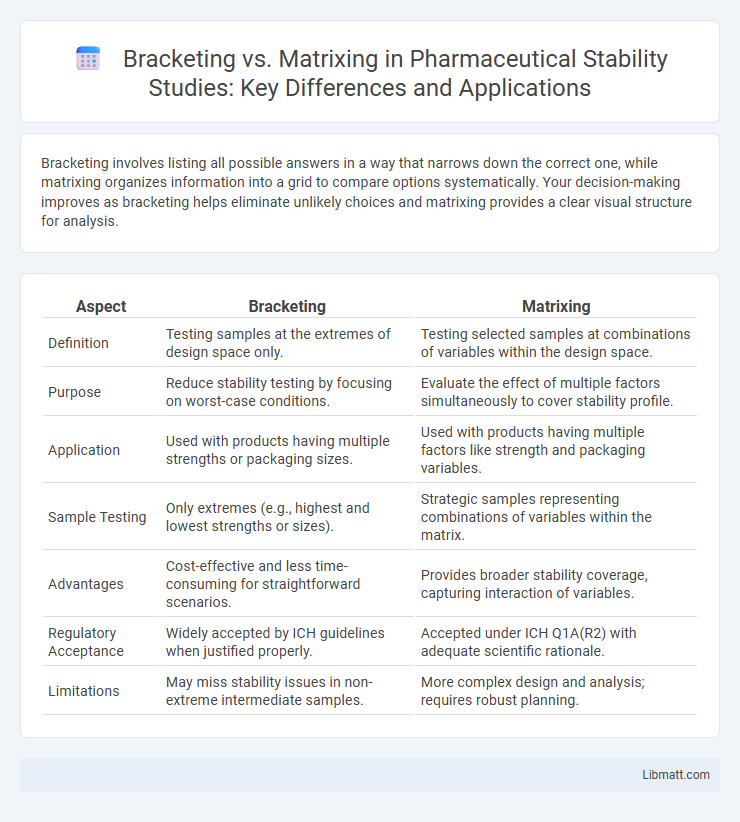Bracketing involves listing all possible answers in a way that narrows down the correct one, while matrixing organizes information into a grid to compare options systematically. Your decision-making improves as bracketing helps eliminate unlikely choices and matrixing provides a clear visual structure for analysis.
Table of Comparison
| Aspect | Bracketing | Matrixing |
|---|---|---|
| Definition | Testing samples at the extremes of design space only. | Testing selected samples at combinations of variables within the design space. |
| Purpose | Reduce stability testing by focusing on worst-case conditions. | Evaluate the effect of multiple factors simultaneously to cover stability profile. |
| Application | Used with products having multiple strengths or packaging sizes. | Used with products having multiple factors like strength and packaging variables. |
| Sample Testing | Only extremes (e.g., highest and lowest strengths or sizes). | Strategic samples representing combinations of variables within the matrix. |
| Advantages | Cost-effective and less time-consuming for straightforward scenarios. | Provides broader stability coverage, capturing interaction of variables. |
| Regulatory Acceptance | Widely accepted by ICH guidelines when justified properly. | Accepted under ICH Q1A(R2) with adequate scientific rationale. |
| Limitations | May miss stability issues in non-extreme intermediate samples. | More complex design and analysis; requires robust planning. |
Introduction to Bracketing and Matrixing
Bracketing in photography involves taking multiple shots of the same scene at different exposure levels to ensure the best image quality under varying lighting conditions. Matrixing or matrix metering evaluates light across the entire frame, using complex algorithms to automatically determine the optimal exposure. Understanding both techniques enables you to capture well-exposed photos in diverse environments and lighting situations.
What is Bracketing?
Bracketing involves identifying and extracting specific themes or data points from qualitative research to categorize information systematically. This technique helps isolate key elements within interview transcripts or observation notes, enhancing clarity and focus during analysis. You can use bracketing to separate relevant insights from biases or peripheral details, ensuring a more accurate interpretation of your data.
What is Matrixing?
Matrixing is a photographic exposure technique that involves organizing multiple images with varying exposures to create a single balanced photo, ensuring detail is preserved in both highlights and shadows. Unlike bracketing, which simply captures several shots at different exposures, matrixing systematically combines these shots to optimize tonal range and dynamic contrast. Your final image benefits from enhanced clarity and detail by integrating the best-exposed areas from each photograph.
Key Differences Between Bracketing and Matrixing
Bracketing involves testing extreme variations of a factor to identify optimal conditions, while matrixing uses a systematic combination of multiple factors across a grid to evaluate their interactions. Bracketing narrows down variables by focusing on boundary values, whereas matrixing provides a comprehensive analysis by exploring all possible factor permutations. Your experimental design benefits from bracketing when seeking specific tolerance limits, and from matrixing when understanding complex factor relationships is essential.
Applications of Bracketing in Practice
Bracketing is widely applied in qualitative research to isolate and control researchers' biases, ensuring the authenticity of participants' experiences. This technique is essential in phenomenological studies where maintaining objectivity while exploring subjective realities enhances data credibility. Your research outcomes gain depth and accuracy by systematically setting aside preconceived notions through bracketing.
Applications of Matrixing in Industry
Matrixing is widely applied in industries like manufacturing, construction, and finance to organize complex data sets and streamline project management. It enables companies to prioritize tasks, allocate resources efficiently, and enhance decision-making through clear visualization of relationships between variables. Your operational efficiency improves significantly by integrating matrixing techniques for risk assessment, quality control, and strategic planning.
Advantages of Bracketing
Bracketing offers precise control over exposure variations, making it ideal for capturing HDR images with balanced lighting and detail in both shadows and highlights. It minimizes the risk of missing optimal exposure settings in challenging lighting conditions, ensuring consistent high-quality results. Bracketing also simplifies post-processing by providing a range of exposures that can be seamlessly merged for enhanced image depth and dynamic range.
Benefits of Matrixing
Matrixing improves project scheduling accuracy by clearly defining task priorities and dependencies, enabling efficient resource allocation across multiple projects. It enhances communication between functional and project managers, fostering collaboration and reducing conflicts in resource usage. Matrixing increases organizational flexibility, allowing teams to adapt quickly to changing project requirements without compromising overall productivity.
Bracketing vs Matrixing: Which to Choose?
Bracketing and matrixing are essential techniques for ensuring accurate exposure in photography, with bracketing capturing multiple shots at different exposures and matrixing using a camera's metering system to analyze the entire scene. Your choice depends on the shooting conditions: bracketing is ideal for challenging lighting or HDR workflows, while matrixing works well for balanced scenes requiring quick, reliable exposure. Understanding the differences helps you achieve optimal image quality tailored to your creative needs.
Conclusion: Optimizing Processes with Bracketing and Matrixing
Bracketing and matrixing techniques enhance decision-making efficiency by structuring complex data sets into manageable segments, improving accuracy and reducing cognitive load. Employing bracketing narrows focus on prioritized variables, while matrixing facilitates multidimensional analysis, enabling comprehensive evaluation of options. Combining these methods optimizes workflow in project management, research, and strategic planning, driving better outcomes through systematic organization and targeted assessment.
Bracketing vs matrixing Infographic

 libmatt.com
libmatt.com